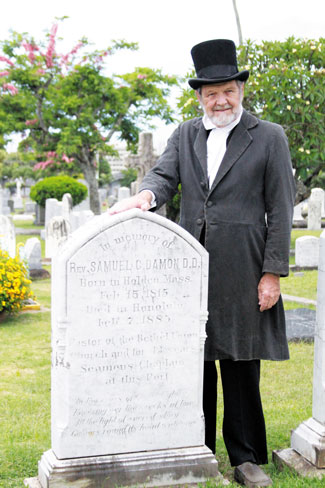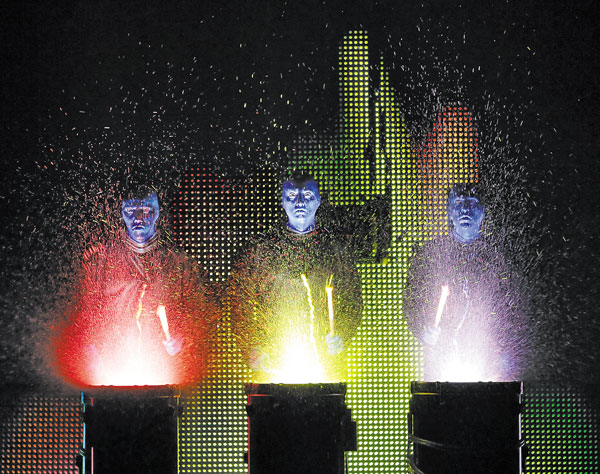Hawaii Welcomes Blue Man
When Chris Smith showed up for an audition with Blue Man Group, he had never seen the show. He had the skill set, being an avid juggler from a young age and doing some clowning, including for Cirque du Soleil.
“All I knew about the show was that they’re those bald, blue things that hit drums and stuff,” says Smith, a native of Denmark who calls South Lake Tahoe, Calif., home. “I wanted to see what it was like to audition for an unclassifiable theatrical show. They said try this and do that, and I just kind of rolled with the punches, because I had no preconceived notions about the show.”
The folks at the audition liked what they saw and sent Smith for training in drumming. And he finally saw the show.
“I sat down in the poncho section, which is close to the stage and you wear a plastic pancho because you’re in the ‘splash zone.’ I had no idea what I was in store for. It was this intense visual and musical celebration, and by the end of it, I felt two things. I thought, what a crazy, cool show. My second thought was, I have to do that? I couldn’t wrap my head around some of the stuff the guys were doing in the show. I wasn’t sure if I was going to be able to learn the specific skill of catching 30 marshmallows in my mouth.”
Apparently he had no problem figuring it out, as he will be onstage at Blue Man’s Hawaii premiere June 18 to 23 at Blaisdell Concert Hall (800-745-3000, broadwayin-hawaii.com). For anyone who’s never seen the show, Smith sums up the experience:
“First and foremost, Blue Man is a really good time. It’s not like any other theater experience – it’s anti-theater, in a way. Where typically you go to the theater and there’s this fourth wall between you and the performers, Blue Man knocks that fourth wall down with a sledgehammer. From the moment the curtain goes up, it’s not a show, it’s an experience that’s shared with the performers and the audience.
“It centers on three bald, blue characters who don’t speak. The only way they can really communicate is through eye contact and drumming. The Blue Man is new to our human environment. He explores things we might take for granted in our day-to-day lives and looks at them with fresh eyes. It gives us an opportunity to look at ourselves from the outside in and maybe have a laugh and get a bit more of a fresh perspective.”
Blue Man is loaded with variety, improvisation and spontaneity. Smith says every show is fresh because it all depends on “where we are, who’s watching and what happens that night.” Technology, particularly social media, is a key theme, including a giant 12-foot iPad, or GiPad, with which the blue men interact.
The Honolulu engagement is the final stop at the end of a nine-month, 54-city tour.
“Honolulu is the city that everybody has been looking forward to the most,” notes Smith. “It’s going to be really fun to immerse ourselves in the culture and see how that translates into the show. You guys are going to be getting the great hurrah!”

Actor Gerald Altwies as Rev. Samuel Chenery Damon | Photo courtesy of Hawaiian Mission Houses Historic Site and Archives
The Dead Come Alive
Hiking Kamananui Trail in Moanalua, you suddenly come upon the ruins of the old Douglas and May Damon homes. That tangible bit of history is full of mystery and excitement. Hawaiian Mission Houses Historic Site and Archives has created a similarly winning formula by having history materialize at its Cemetery Pupu Theatre (June 14-22; missionhouses.org, 447-3926). Celebrated community actors will embody five key characters from Hawaii’s days of yore. Dressed in the day’s fashion, they will stand beside the Nuuanu gravestone of the actual character and flesh out that individuals’ life story, including that of Rev. Samuel Chenery Damon, the grandfather of the aforementioned Damon siblings. Other characters, of varying genders and points of views, who will be portrayed are Mary Dowsett, wife of Capt. Samuel Dowsett; Lydia Panioikawai French, wife of early merchant William French; early merchant John Meek; and Capt. Isaac Hart.
“This is the fourth set of original scripts for this program,” says Mission Houses curator Mike Smola, who spent two months visiting every receptacle of knowledge on Hawaii’s history (State Archives, Hawaiian Historical Society Library, Hawaiian Mission Houses Archives, Bishop Museum Archives, Hamilton Library) to re-create the five chosen characters. “We pick people who had an impact on the history of Hawaii and who have an under-told story.”
A collaboration of research, scriptwriting and acting will bring out the complexity and background context of the characters.
“One of the biggest considerations is how to get the emotional content of the script to come out in the performance,” points out Smola. “The research is all facts, but how do we get at their feelings about their lives? How do we make them rounded and with a full personality?”
While doing his research, Smola discovered intriguing tidbits about the characters:
“One little anecdote I ran across is that James Isaac Dowsett (son of Capt. Dowsett and Mary) once accidentally shot his mother – non-fatally! – when he was a teenager. He loaded a pistol to shoot at a bird, it ricocheted and hit his mother in the hip when she was engaged in ‘the necessary.’ She walked with a limp after that.
“The account of the rescue mission for Capt. Dowsett in 1835 is a gripping tale of a young captain and his bull-headedness when confronting the natives in Micronesia. Interestingly, it was the Hawaiian government that sent the rescue mission to search for Capt. Dowsett.
“I am really excited about presenting Capt. John Meek, who was such a big part of the early commerce of the Islands, and Rev. Samuel Chenery Da-mon, who was so integral to life in the port of Honolulu throughout the 1800s and a fixture in the community for both sailors and foreign residents.”
The evening intrigue comes with pupu and drinks – pupu at 5 p.m., performance at 6. Don’t be … late.






